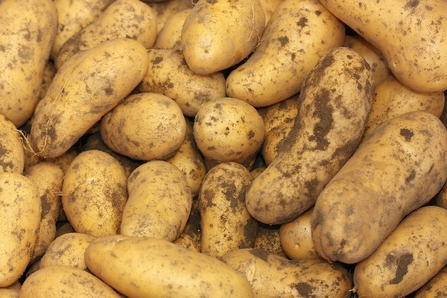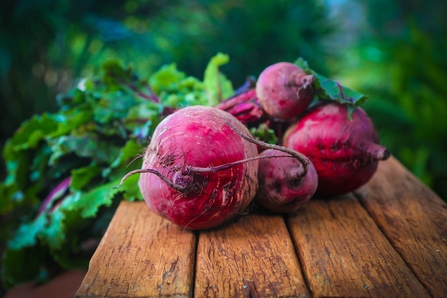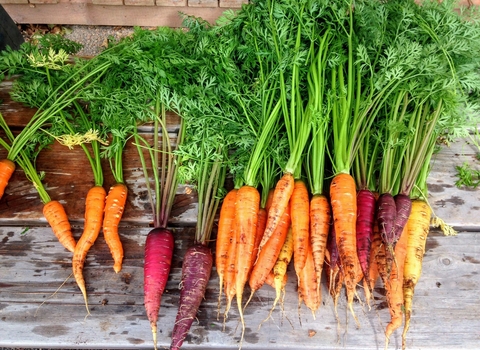Root Veg Unearthed
These crops are all grown in the same way – the bit you harvest grows underground. Some root crops, like carrots, do better in sandy soils than heavy clay soils, but you can grow them in containers of peat-free, multi-purpose compost if you need to create better conditions for them. Potatoes are the easiest root crop to grow – simply bury the tubers 30cm deep and 30cm apart. When the first leaves emerge, cover them with soil to prevent the sun from reaching the developing tubers (known as “earthing up”) and harvest in late summer.
Top Tips
To keep your crops healthy and growing well, you need a balance of insects (a good mix of pollinators, predators and prey). We’ve already mentioned growing flowers for pollinators, but have you heard of companion plants? These are used specifically to help another crop grow. Worried about carrot fly laying eggs in your carrots? Grow strong-smelling onions alongside them to confuse her.

How to grow potatoes
What?
Potatoes come in different types. New potatoes are the small, early ones and are well worth growing yourself. You don’t even need a garden because you can grow these in special bags, piles of tyres, or planters. It is often not worth growing maincrop potatoes – these are the larger sort – as they can be bought very cheaply, and take up a lot of room to grow.
Potatoes are grown from “seed potatoes” which are very small tubers which have a lot of “eyes” – the tiny buds from which the shoots sprout. You can enjoy an earlier crop by placing these seed potatoes onto a bright windowsill to “chit”, which just means allowing them to sprout a bit before you plant them. But you don’t have to do this.
Where?
Potato bags, planters and containers, or outside. They like normal garden compost with some loam – the soil from the tops of mole hills is excellent – and mix in a bit of general organic fertiliser if you have it.
When?
You can buy seed potatoes from late January onwards. If you plant them in February or March, you will need to keep them in a container in a frost-free place like a conservatory at first, and they will be ready to eat in May or June.
You can plant them outside from the beginning of April, about 10 to 12 centimetres deep, in rows that are 50 to 60 centimetres apart. Keep the potatoes about 30 centimetres apart within the rows. If you are in the north and still at risk of frost, the potatoes will be fine if they are still underground. But if they are poking out with shoots, cover them with something like newspaper or fleece.
When the shoots reach 20 centimetres tall, bank up soil around them. This is called “earthing up” and stops parts of the potatoes going green. Basically, keep putting soil up around them to stop the light getting to the potatoes.
Keep plants well-watered. Outdoor potatoes can be eaten from July.

How to grow beetroot
What?
Beetroot seeds can be given a head start by soaking them in water for a few hours before sowing them, or you can put them between some sheets of very wet kitchen paper on a plate, and keep it wet. Plant out when you can see tiny roots.
Watch out for beetroot “bolting.” This means it starts to flower before you have had a chance to harvest it, which you don’t want it to do. It makes the root small and tough and stops it growing. You can buy “bolt-resistant” types, or just make sure to harvest early enough while the vegetable is small and sweet.
Where?
Beetroot doesn’t like waterlogged soil. Make sure it’s good, well-drained, and fertile. Make little holes in the soil that are about 5 centimetres apart, and put two seeds in each hole. Keep the rows about 30 centimetres apart. When you see the seedlings come up, if you get two in one place, keep the strongest and pull out the weaker one.
You can grow beetroot in containers and pots outside.
When?
In the south, you can sow from March onwards but colder areas will need to wait until April or get the plants started inside. It’s best to sow a few new seeds every few weeks, so you have a constant supply of beetroots until November. You can harvest them between from about two months after sowing.

